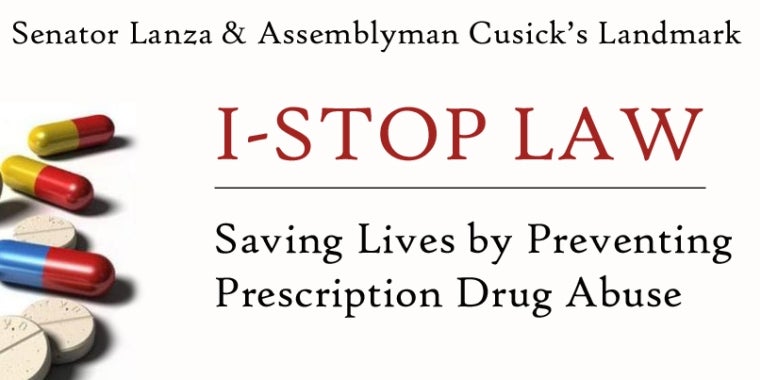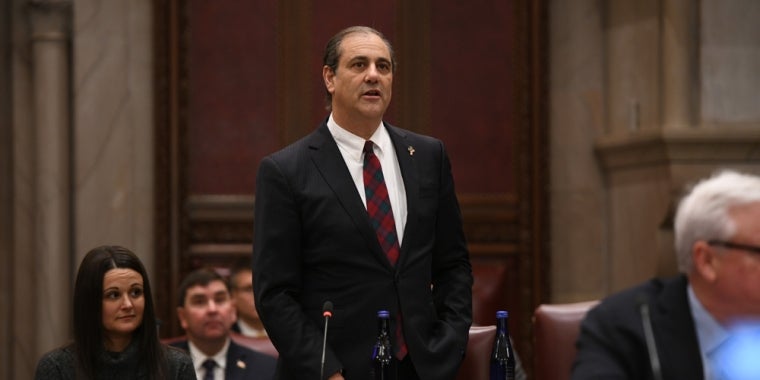
Senator Andrew Lanza Announces Progress on State's Efforts to Crack Down on Prescription Drug Abuse
Andrew J Lanza
February 3, 2014

Program’s Success Detailed at Joint Legislative Public Hearing on the 2014-2015 Health and Medicaid Executive Budget Proposal
Senator Andrew Lanza today announced progress of New York State’s efforts to crack down on prescription drug abuse through the successful implementation of his legislation, the Internet System for Tracking Over-Prescribing Act (I-STOP) and other portions of the recent Prescription Drug Reform law. Under this legislation, more than 66,000 health care professionals across the State have run more than seven million individual prescription checks on nearly three million separate patients since August 2013.
By comparison, the State’s older prescription monitoring program that predated these reforms was only utilized by approximately 5,000 practitioners who checked less than 500,000 patients over a three and a half year period.
Senator Lanza said, "I-STOP has become a national model for more effectively tracking controlled substances by requiring pharmacies to report prescription information to New York's prescription monitoring program registry in 'real time'. I-STOP allows doctors to monitor their own patients’ medication histories, a critical tool for responsible physicians.The use of this information not only protects health care providers when they prescribe medications for legitimate patients but it also curbs prescription drug abuse."
To address the epidemic of prescription drug abuse aggressively, Senator Lanza and Assemblyman Cusick enacted the Prescription Drug Reform law, which includes I-STOP. I-STOP is administered by the DOH Bureau of Narcotic Enforcement (BNE). In accordance with I-STOP, DOH rolled out the new Prescription Monitoring Program (PMP) Registry on June 12, 2013 over two months ahead of schedule.
The enhanced PMP system substantially decreases opportunities for "doctor shoppers" to illegally obtain prescriptions from multiple practitioners. This system improves DOH’s secure prescription monitoring program registry, which includes information about dispensed controlled substances reported by pharmacies on a "real time" basis, to effectively stop doctor shopping and combat the circulation of illegally-obtained prescription drugs. The PMP Registry is secure and easily accessible by practitioners and pharmacists, allowing them to view their patients’ controlled substance history. Most importantly, this information will improve clinical decisions made by practitioners and pharmacists regarding appropriate use of controlled substances.
Since I-STOP's effective date of August 27, 2013, the PMP Registry system has been widely used. The feedback we've received from the individuals who use the new PMP has been overwhelmingly positive. Since I-STOP’s effective date, 66,369 health care professionals have performed nearly seven million individual searches for 2,879,140 separate patients. To put that in context, 5,096 practitioners performed approximately 465,930 searches during the first 3 ½ years of the old PMP (which began in February 2010).
The expanded use of the PMP Registry has already produced dramatic results. For example, there was a 74.9 percent decrease in the number of individuals engaged in doctor shopping when comparing the 4th quarter of 2013 to the 4th quarter of 2012. While data concerning overdoses and addiction treatment rates will not be immediately available, this data indicates that the PMP Registry has already had a positive effect.
The law also combats prescription drug abuse by removing hydrocodone from Schedule III and placing it on the more-restrictive Schedule II regardless of formulation. This is significant as hydrocodone has been the most prescribed controlled substance in New York State, with more than four million prescriptions created each year over the last four years. Since the enactment of I-STOP, the rate of prescribing hydrocodone has decreased at an accelerated rate. During the second half of 2013, there were 19.6 percent fewer prescriptions for hydrocodone than there was during the same time period of 2012. Recently, the FDA followed New York State’s lead and also revised hydrocodone from schedule III to schedule II.
This law also created a safe disposal program regarding prescription drugs. DOH, in partnership with the New York State Office of Alcohol and Substance Abuse Services and other state agencies, worked with the NYS Police and local police departments to establish secure disposal sites for controlled substances on the premises of police stations across the state. At these sites, individuals can voluntarily surrender unwanted and unused controlled substances. These substances are then disposed of in an environmentally friendly fashion.
Studies show that a majority of abused prescription drugs are obtained from family and friends, including the home medicine cabinet. To help address this problem, the Department has established a permanent medication drop box program through the state, county, and local law enforcement agencies. A listing of medication drop boxes by county can be found here.
Electronic prescribing of controlled substances (EPCS) is now permitted in New York State, and it becomes mandatory in March 2015. Requiring compliance with the DEA's security standards, EPCS ensures that prescriptions are authentic, eliminating the opportunity for forgeries and stolen prescription pads. New York is the first state in the country to require electronic prescribing.
I-STOP also requires improving education and awareness of prescribers to stem the tide of prescription drug abuse. The law expands the functions of the workgroup established by DOH under the existing Prescription Pain Medication Awareness Program. This workgroup is comprised of various stakeholders including consumer advocacy organizations, health care practitioners and providers, pharmacists and pharmacies, and representatives of law enforcement agencies. As charged, the workgroup developed recommendations on continuing education for practitioners and pharmacists on pain management issues. DOH is actively considering these recommendations. The workgroup also advised DOH on the implementation of this law, while seeking to protect and promote access by patients with a legitimate need for controlled substances.
Share this Article or Press Release
Newsroom
Go to Newsroom
Senator Lanza 2023 Veteran Hall of Fame
November 10, 2023

Home Energy Assistance Program (HEAP)
November 2, 2023

